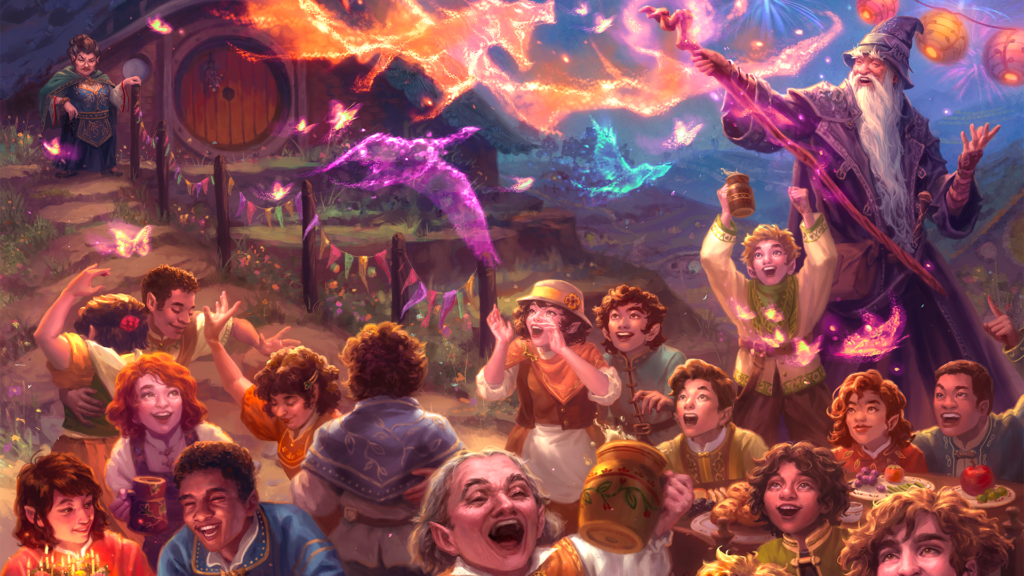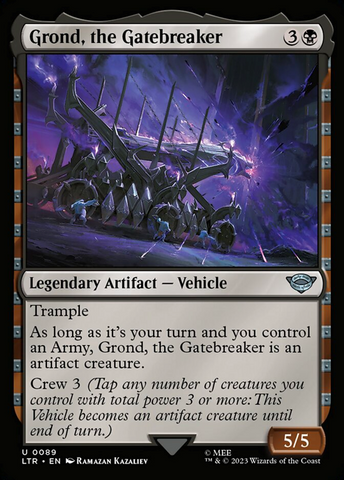Menu

0
Your Cart is Empty

Your Cart is Empty

June 27, 2023 5 min read 0 Comments
Indulging in the captivating world of Magic: The Gathering brings us not only breathtaking artwork but also an opportunity to immerse ourselves in tales woven within each card. That’s something that’s evident in the newest set: Lord of the Rings: Tales of Middle Earth.
I am excited to share my seven favorite card text and art combinations from the newest set. These gems not only feature awe-inspiring art but also conceal elusive easter eggs that may have eluded even the most astute observers!

In the artwork for Lobelia Sackville-Baggins, there are delightful nods to her shared history with her cousin-in-law, the renowned Bilbo Baggins. One cannot help but be drawn to the intriguing details that unravel a tale of mischievous connections and lost treasures.
The first striking element is Lobelia's presence in none other than
Legend has it that while Bilbo was away embarking on daring adventures with Thorin and Company, Lobelia and her husband saw an opportunity to auction off various items from Bag End. Among the unfortunate losses was Bilbo's prized silverware, an artifact of sentimental value. The artwork masterfully captures Lobelia holding a treasure – which her card makes – that is in turn a set of the silverware itself, gifted back to her.

The art for There and Back Again is a fantastic use of the saga formatting, captivating viewers with its evocative symbolism and immersive storytelling that connects the artwork to the rules text of the card itself.
The top of the card presents the temptation of the Lonely Mountain, reminiscent of The Ring Tempts You. This transition flawlessly leads us to the second part, where the focus shifts to the quest of searching for a Mountain. As we venture deeper into the artwork, our gaze is captured by the awe-inspiring presence of Smaug, guarding his colossal hoard of treasure. This larger part of the art serves as a powerful reminder of Smaug's might and the vast wealth he has amassed for himself.
In an intriguing twist, part III of the card introduces a 6/6 Red Dragon with “When this creature dies, create fourteen Treasure tokens,” symbolizing Smaug himself. This ability to create 14 treasure tokens echoes the pivotal moment in 'The Hobbit' when Smaug's wealth becomes available for the taking of the 14 members of the party. In the realm of Magic, it is the player who claims this vast fortune.

The artwork for this skillfully incorporates the card's rules text into its visual representation. With the presence of three Ringwraiths depicted in the art, the card's effect becomes apparent: when it enters play, a targeted creature receives a -3/-3 reduction in power and toughness (and if it is legendary, its controller loses 3 life as well). This artistic choice beautifully reflects the essence of the Ringwraiths and their relentless pursuit of the One Ring.
For those familiar with The Lord of the Rings, the connection is immediately recognizable. When one puts on the ring, the Ringwraiths become aware of the wearer's presence and relentlessly track them down to retrieve the precious artifact. The notion that "you cannot kill what is already dead" is intrinsic to the Ringwraiths' existence, as they exist in a state between life and death, making them formidable adversaries.
By visually incorporating the Ringwraiths into the artwork, the card not only pays homage to the lore but also enhances the gameplay experience. It invites players to immerse themselves in the world of Middle-earth and relive the tension and danger associated with encountering these haunting figures. This card stands as a testament to the seamless integration of art and mechanics, making it a captivating addition to any Lord of the Rings-themed game or collection.

The art for Bill Ferny, Bree Swindler captures the essence of a classic rogue character with its portrayal of Bill perched on a fence under the shimmering light of a full moon. The art also alludes to Bill's profession as a seller of horses and ponies, posing the question of how much one would be willing to pay for such a steed, especially if you happen to be a hobbit.
In the story, Bill commanded a price three times the usual value, as depicted in the art where he sells a pony for 12 silver pennies to Aragorn and the hobbits. Although we can visibly see seven coins in the artwork, I like to think there are five more behind the nameplate. Furthermore, the card's ability showcases Bill's cunning nature, as he generates three treasure tokens, each representing the value of the horse hidden behind him, that he will so generously sell to you.

Grond, the Gatebreaker holds a hidden delight within its art for keen observers. By examining the wheels of this formidable card, one can spot three vigilant orcs operating it. This attention to detail perfectly complements the card's Crew ability of 3, cleverly symbolized by the trio of miniature warriors integrated seamlessly into the artwork. Such thoughtful design choices bring an extra layer of immersion and fascination to the world of Magic.

Tom Bombadil, the epitome of a bard, proves to be a remarkable commander choice for a saga-themed deck. Yet, the artwork of Tom Bombadil's card offers more subtle details to explore. In connection with his first ability, which activates when there are four or more counters on sagas under your control, one can notice four delicate butterflies gracefully fluttering around his outstretched hand. These butterflies serve as an artistic representation of the counters on the sagas and subtly imply their influence over Tom Bombadil's powers. Moreover, the card's artwork unveils an intriguing aspect of his second ability—limited to triggering only once per turn. Among the four butterflies, only a solitary one shines in a vibrant shade of red, symbolizing the singular opportunity for this ability to be used each turn.

The artwork for Sauron's Ransom captivates the essence of the card's mechanics through its visual depiction. Upon observing the image, one immediately grasps the essence of the card's effect. The artwork portrays four distinct pictures, cleverly arranged into two discernible groups. This arrangement mirrors the card's ability, which allows players to examine the top four cards of their library and separate them into two distinct piles. Furthermore, the artwork incorporates color psychology to enhance the narrative. The sky behind the groups of pictures employs red and black hues, symbolizing the association with malevolent characters, such as Sauron. In contrast, shades of blue and white are employed to represent the virtuous protagonists. This intentional use of color effectively reinforces the dichotomy between good and evil, adding depth and visual impact to the artwork of Sauron's Ransom.
It delights me to discover the hidden gems, like the easter eggs on these cards, that pay homage to the captivating story and lore of the beloved Lord of the Rings series. The artists have truly demonstrated their exceptional talent by masterfully capturing the very essence of Tolkien's world, creating a magical tapestry that fans like myself can truly appreciate and cherish. I cannot wait to unearth more of these amazing connections that bridge the realms of imagination and reality.
Sign up to get the latest on sales, new releases and more …